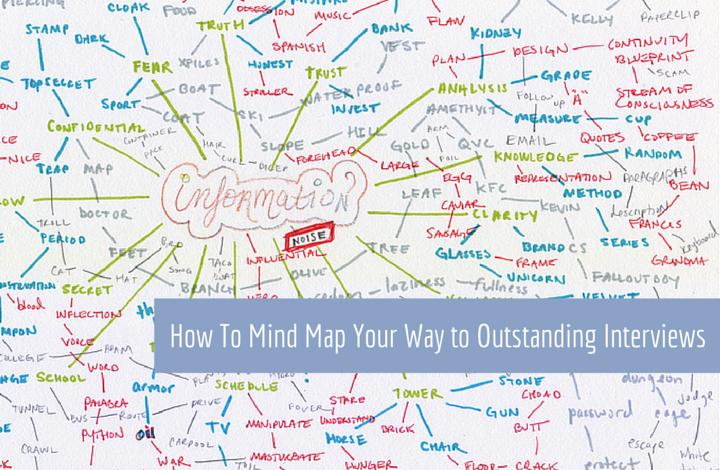When interviewing people, you learn a lot in a short amount of time and get insights that aren’t in a press kit or on a FAQ page. I regularly interview musicians, CEOs, startup founders, community organizers, executive directors, local changemakers, and everyday people. Each interview is different—some are great, some are a challenge, and most fall somewhere in the middle—but the way I prep for them is the same: I mind map them.
Mind mapping allows you to do a big brain dump and visualize what information you’re working with. This leads to more efficient preparation and planning for a wide variety of projects for work, play, or anything in between.
In the Lifehacker article “How to Use Mind Maps to Unleash Your Brain’s Creativity and Potential,” Melanie Pinola writes, “Beyond just note-taking…mind maps can help you become more creative, remember more, and solve problems more effectively.”
Whether interviewing a local gardener or a business executive, mind mapping helps you discover areas you’d like to cover, find natural associations between topics, and see if there are any holes or if your angle is imbalanced one way or another. Plus, once you start writing ideas down, other ideas come flooding in and connections between ideas are made. In the article “Mind Mapping Benefits,” experienced mind mapper and trainer Clive Lewis explains:
“Mind Maps are an ideal tool for understanding inter-relationships between different aspects of a situation. By focusing on meaning rather than worrying about grammar and semantics, the Mind Map helps people to rapidly build up an enhanced understanding of any problem, challenge or situation.”
Creating a mind map is simple. You need a piece of paper and something to write with (there are mind mapping software programs but I prefer the hands-on approach); a decent understanding of your interview subject (do some research ahead of time); and a willingness to freely write down ideas without editing yourself. I’ll walk you through the rest.
If I were interviewing Madonna, this is how I would start
For the sake of example, I mind mapped Madonna as a potential interview subject because everyone knows her and she’s a multi-faceted, interesting subject. This is how I would prepare to interview her using a mind map. Modify these steps to suit your needs, interests and style.
Start at the Center
At the center of the paper, write down your subject’s name (this may be an organization, or band…whatever the focus of your interview is). I like to circle my mind map topics because it keeps the whole map tidier and easier to decipher.
Let the Brain Dump Commence
From the center point, start adding topics you’d like to cover. This doesn’t need to take long. Mind mapping an interview generally takes me about 10-15 minutes. Once you’ve developed your own mind mapping routine, you can find ways to make it more efficient. The Lifehacker article “How to speed up your mind mapping: Tricks of the trade” offers several ways to fast track the mind mapping process.
At this point, you’re just mapping things you may want to talk about, areas of interest, questions you have, etc. Don’t edit yourself here—the value of mind mapping is that it inspires thinking about your subject in new ways.
For Madonna, the first thing I wrote down is that she has a new album. Artists need to do marketing and promotion, so talking about their latest project is a must-do for them.
I also want to know about her recent fall at the Brit Awards. In particular, I want to talk about how awesome it was that she got right up and finished the song, even though her voice trembled for a few seconds. Pure pro.
Madonna chose to use social media to let fans know she was OK after the fall, posting the following message on her Instagram:
I would ask Madonna about social media and the immediacy of it. I’d also get her perspective on how it has changed the music business, and what she thinks of it in general. Looking at my growing mind map, it becomes clear that this would be an interesting angle to chat about with her. In fact, if I were really writing an article about Madonna, I might lead with this. This social media angle was one that came about as I mind mapped. I knew I would ask about the fall, but mapping led me to the social media questions.
I’m also curious about her family—specifically, how it is raising kids under such a bright spotlight. I’d ask about her current fitness routine (is she still doing three hours of yoga a day?), and what she’s working on next. I wrote down “history,” but Madonna is so well known and there’s so much information out there already about her, I probably wouldn’t spend time going down that road…unless there was something I really wanted to know, or she opened up about something interesting in her past.
If one area of your map has a lot of branches, you need to spend more time exploring this area, or distill your questions into the most important aspects of the topic. Maybe you want to drill down on one particular theme or topic, but generally, you’ll need to cover a bit of ground to give you enough material to create a textured, interesting article.
Mind mapping taken to an artform. Map by Paul Foreman of Mind Map Inspiration
Take In the View
Once you’ve brain dumped, take it all in. What areas need more exploring, where are there gaps in your map? What information do you need to fill the holes? If you’re happy with what you have, great. If you need more, continue brainstorming and dumping.
Pro tip: The best interviews go off in unexpected directions. When this happens, go with it! Mind mapping is designed to give you a solid and well-rounded foundation to work from. If Madonna started telling me about her childhood memories or an amazing experience she had last week, that’s where the interview would go.
Customize It
For my purposes, a simple map style works fine, but some people take mind mapping to an artform. If you want to get creative, you can add color, drawings, different shapes—whatever you like. If you want inspiration, check out Mind Map Inspiration, or the Mind Map Art Gallery, a collection of stunningly colorful, creative and intricate mind maps.
Sometimes my mind maps are simple and other times they’re very involved. For a feature article I wrote about the sharing economy in Seoul, South Korea, that involved numerous interviews, tons of data, and several different angles, I had a handful of messy and involved mind maps. But, they helped me visualize an immense amount of information and organize the article.
Prep Your Questions
Now that you know the areas you’d like to cover, start putting together specific questions to get to the heart of the topics. Between the mind map and your questions, you’ve already started outlining your article. This is great as it reduces the time you spend prepping and writing the article. Anything that makes us faster, more efficient writers and freelancers is a good thing.
More About Mind Maps
The term “mind maps” was created by Tony Buzan in the 1970s, but this kind of visual exercise dates back hundreds of years, if not more. Similar exercises are called spider diagrams, spray diagrams, concept mapping, etc. Regardless of what the practice is called, the idea is the same: get linear, unconnected thoughts into a visual, creativity-inducing medium. Buzan’s instructions for mind mapping are as follows:
- Start in the center with an image of the topic, using at least three colors.
- Use images, symbols, codes, and dimensions throughout your mind map.
- Select key words and print using upper or lower case letters.
- Each word/image is best alone and sitting on its own line.
- The lines should be connected, starting from the central image.
- The lines become thinner as they radiate out from the center.
- Make the lines the same length as the word/image they support.
- Use multiple colors throughout the mind map, for visual stimulation and also for encoding or grouping.
- Develop your own personal style of mind mapping.
- Use emphasis and show associations in your mind map.
- Keep the mind map clear by using radial hierarchy or outlines to embrace your branches.
In the following video, Buzan calls a mind map a swiss army knife for the brain. “Anything I wanted to do in terms of thinking, contemplation, cognition, remembering, creating,” he says, “the mind map was the ideal tool for that.”
Related Reading
Boost Your Freelance Productivity with This Easy Scheduling Hack
13 Pro Tips for New Freelance Writers
6 Valuable Lessons I’ve Learned About Freelance Writing
Top photo: Jessica Mullen (CC-BY-20)









